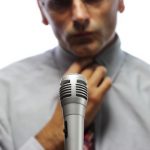 Public speaking is widely regarded as one of the most nerve wracking things we can do in our professional lives, and I’ve written a few times about various technologies that aim to help you, whether it’s an AI that will write your speech for you, a VR environment to allow you to practice, or augmented glasses to give you live feedback as you present.
Public speaking is widely regarded as one of the most nerve wracking things we can do in our professional lives, and I’ve written a few times about various technologies that aim to help you, whether it’s an AI that will write your speech for you, a VR environment to allow you to practice, or augmented glasses to give you live feedback as you present.
These are all well and good, but there is still no getting away from the actual act of standing up in front of an audience and doing your thing. One of the trickiest parts of public speaking is knowing where to look. Whilst thankfully the old advice to imagine the audience naked is seldom trotted out, there is still a degree of confusion as to whether you should focus on a friendly face, or scan the room.
It’s probably fair to say that the consensus is to spread your gaze around to create the impression that you’re speaking to the whole room, but how do you respond to the expressions on those faces as you glance about?
Non-verbal feedback
That’s the question posed by a recent Chinese study that asked participants to deliver an impromptu presentation to an apparently live audience via Skype. The participants were a mixture of those who get very nervous in such circumstances and those who take it more in their stride.
The ‘audience’ was actually a group of actors that had been pre-recorded and instructed to be positive, negative or neutral. The ‘speakers’ were then monitored for signs of stress such as a raised pulse and sweating. At the end of their speech they were quizzed on how it went and how they felt.
Whilst we may assume that the way we gaze amongst an audience is random, the findings suggest our predisposition towards public speaking plays a big part in the faces we pick out in the crowd.
For instance, if we’re nervous public speakers, then the results suggest that we’re more likely to find and focus on negative audience members, with the reverse the case if we’re more positive about speaking.
This manifested itself quite predictably, with those anxious beforehand also reporting high anxiety levels at the end of their speech. This was mirrored in their physiology, with anxious speakers having higher heart rate and a greater propensity to sweat.
Whilst the study doesn’t provide a great deal of help and support for those anxious speakers, it does provide us with some insight into what appears to be a self-fulfilling prophecy, as the confident speakers focus much more of their energy on those that confirm their belief that they’re speech is engaging, whilst the anxious speakers do the opposite.
Maybe that realization in itself is enough to help anxious speakers work on picking out the more optimistic members of their audience.
Interesting tips, thanks Adi.